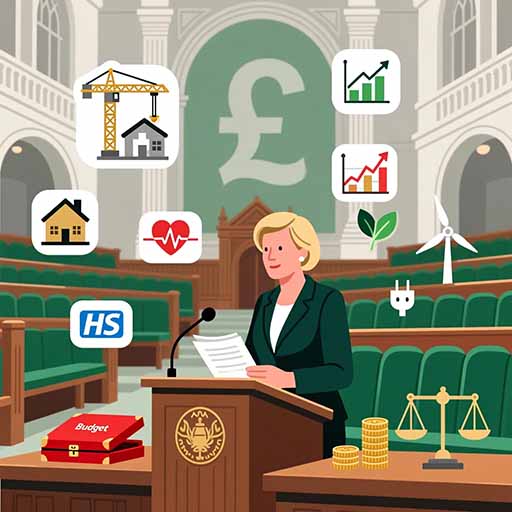The Budget 2025 has been leaked early by The Office for Budget Responsibility’s latest Economic and Fiscal Outlook and it effectively confirms that Budget 2025 is dominated by tax rises, with only limited offsets elsewhere. For readers who have followed our earlier Autumn Budget 2025 predictions, many of the big moves will feel strikingly familiar; but the scale and breadth of these measures goes beyond what most households and businesses expected.
Tax burden heading to a post‑war high
The OBR confirms that, once the Autumn Budget 2025 measures are fully in place, the UK tax take will rise to around 38% of GDP by 2030–31, the highest level on record and roughly five percentage points above its pre‑pandemic share. Around two‑thirds of that increase is driven by personal taxes. In other words, rather than coming through stealthy business‑only changes, the bulk of the fiscal tightening will be felt directly by employees, pension savers, landlords, and investors.
We anticipated more pressure on higher earners and capital income, possibly via threshold freezes and investment tax tweaks. The newly released figures confirm that the Government has not only followed that path, but also locked in further rises deep into the next Parliament.
Extended income tax threshold freezes: fiscal drag turned up to eleven
One of the most significant tax decisions buried in the official documentation is an extension of the freeze on personal income tax thresholds and employer National Insurance thresholds. These thresholds, originally intended to be frozen until April 2028, will now remain fixed for an additional three years, through to April 2031.
Because wages are expected to grow over this period, more income is dragged into higher tax bands – the classic effect of "fiscal drag". The OBR estimates that by 2029–30 this extended freeze alone raises around £8 billion a year. It also transforms the shape of the taxpayer population: by the end of the decade, roughly 780,000 more basic‑rate taxpayers, 920,000 more higher‑rate taxpayers, and around 4,000 additional‑rate taxpayers will exist compared with a scenario where thresholds had been allowed to rise normally.
For ordinary earners, the effect is subtle but powerful. You may not notice a headline rate change in the Budget speech, but year by year more of your income will be taxed at 20%, 40% or 45%. Combined with inflation, this is one of the most material contributors to the rising overall tax burden. When we previously analysed possible outcomes we described threshold freezes as a "quiet tax rise"; the new OBR figures show just how loud that "quiet" policy now is.
NICs hit salary‑sacrifice pensions: squeezing tax‑efficient saving
Another key policy that has emerged from the Economic and Fiscal Outlook is a change to the treatment of salary‑sacrificed pension contributions for National Insurance purposes. Currently, salary sacrifice is widely used to reduce both employer and employee NICs, while boosting pension savings. Under the new rules, NICs will be charged on salary‑sacrificed pension contributions, sharply limiting the National Insurance advantage of this common planning strategy.
The OBR expects this policy alone to raise around £4.7 billion a year by 2029–30. For many employees in larger organisations and the public sector – where salary sacrifice for pensions is standard – the effect will be a noticeable increase in total employment costs, part of which may feed through into pay restraint or lower net incomes. It also nudges the system away from tax‑efficient pension saving, at the very moment when long‑term retirement planning is already under strain from inflation and market volatility.
Investment income: 2‑point rate rise for dividends, property and savings
The leaked details also confirm that income tax rates on dividends, property income and savings income will rise by 2 percentage points across the board. This is a direct and transparent tax rise on:
- Private investors who receive dividends from shares or funds outside ISAs;
- Landlords with rental profits taxed through self‑assessment; and
- Individuals with substantial taxable savings interest.
By 2029–30, the OBR expects this set of changes to add around £2.1 billion to annual receipts. While that figure is modest relative to the overall tax take, it is heavily concentrated among higher‑income and asset‑owning households. Taken alongside the extension of threshold freezes, the measures form a coherent – and deliberate – tilt towards taxing wealth and investment returns more heavily.
From a planning perspective, the Budget leak underlines the importance of maximising tax‑sheltered wrappers (such as ISAs and pensions), reviewing the ownership structure of rental properties, and reconsidering the balance between income‑producing and growth‑orientated assets. These are the same themes we raised in our Autumn Budget 2025 is on November 26th – Our Predictions piece, now made more urgent by confirmed numbers.
New mileage‑based tax on electric and plug‑in hybrid cars
Perhaps the most symbolic change is the arrival of a new mileage‑based charge on electric and plug‑in hybrid cars. From April 2028, drivers of battery electric and plug‑in hybrid vehicles will face a per‑mile tax set at about half the effective fuel duty rate paid by petrol drivers. While the precise mechanism is still to be fully designed, the OBR treats this as a new central government tax, expected to raise around £1.4 billion in 2029–30.
This marks a significant turning point in the transition to net zero. Up to now, electric vehicles have attracted generous tax advantages – lower fuel costs, VED changes, and company car benefits. As EV adoption has accelerated, the Treasury has become increasingly concerned about the long‑term erosion of fuel duty revenues. The new charge is the first explicit step towards replacing the traditional fuel duty model with a more generalised road‑pricing‑style tax.
For motorists, especially high‑mileage drivers, this will be a key factor in total running costs from the late 2020s onwards. It also raises the question of how long plug‑in hybrids will continue to be treated differently from conventional petrol and diesel cars. We previously suggested that fuel duty would eventually have to be replaced; the OBR numbers make clear that the process has now begun.
Fuel duty: yet another freeze now, but higher rates locked in later
In the nearer term, the Government is extending the freeze on fuel duty for an additional five months, with a plan for staged increases from September 2026. Relative to previous plans, this short‑term freeze costs the Exchequer about £2.4 billion next year, but the subsequent staged rises still leave the medium‑term fuel tax take higher than it would have been if duty had simply been left to erode in real terms.
This combination – another politically popular freeze now, paired with a firm schedule of future increases and the new EV mileage charge – shows how the Treasury is trying to bridge today’s cost‑of‑living concerns with tomorrow’s revenue requirements. However, for household budgeting, the message is clear: the era of ultra‑cheap motoring taxation is drawing to a close.
Business and capital taxes: writing‑down allowances, gambling, and more
On the corporate side, the OBR documents highlight a series of smaller but cumulatively significant tax rises:
- Reduction in the main rate of writing‑down allowances for corporation tax, expected to raise about £1.5 billion a year by 2029–30. This effectively increases the tax cost of capital investment, by slowing the rate at which businesses can deduct depreciation for tax purposes.
- Reforms to gambling taxation, projected to raise around £1.1 billion a year by 2029–30. The exact shape involves rebalancing rates and bases across different forms of gambling, but the overall direction is clear: a higher tax take from the sector.
- Reduced capital gains tax relief on disposals to Employee Ownership Trusts, expected to add about £0.9 billion a year once fully in place. This makes EOT structures less tax‑privileged and may change how some owner‑managers structure business succession.
In addition, there is a broader package of tax administration, compliance, and debt collection measures – including greater use of third‑party data, enhanced "transactional risking" for VAT and corporation tax, and targeted anti‑avoidance measures for non‑doms, construction industry schemes, and loan arrangements. Altogether, these raise about £2.3 billion a year by 2029–30, according to the OBR.
High‑value property and new levies
Beyond council tax and income taxes, several niche but important measures round out the picture:
- A high‑value council tax surcharge on properties worth more than £2 million, raising roughly £0.4 billion annually by the end of the forecast.
- Introduction of the Sizewell C Regulated Asset Base (RAB) levy, treated by the OBR as a new central government tax and contributing to overall receipts.
- A new international student levy, likewise recorded as a central government tax and adding to the medium‑term revenue profile.
Individually, these taxes are small in macro terms, but they all point in the same direction: the tax system is being used aggressively to raise more revenue from assets, higher‑value properties, and specific sectors perceived as able to bear additional charges.
Putting it all together: a broad‑based tax rise, not a single headline hike
What makes Budget 2025 so striking is not a single spectacular rate rise, but the cumulative effect of dozens of changes. Extended freezes to thresholds, tweaks to investment and property income rates, new levies on EVs and infrastructure, tighter reliefs for business owners, and far‑reaching compliance measures combine to produce one of the largest medium‑term tax rises the OBR has recorded since its creation.
With the OBR’s detailed forecasts now in the public domain, Budget 2025 has effectively leaked early, and the message is unambiguous: many tax rises are coming, and they are here to stay.. We now await the full Budget documents to see clearer details on each of these changes.
We have a number of tools to help you:


